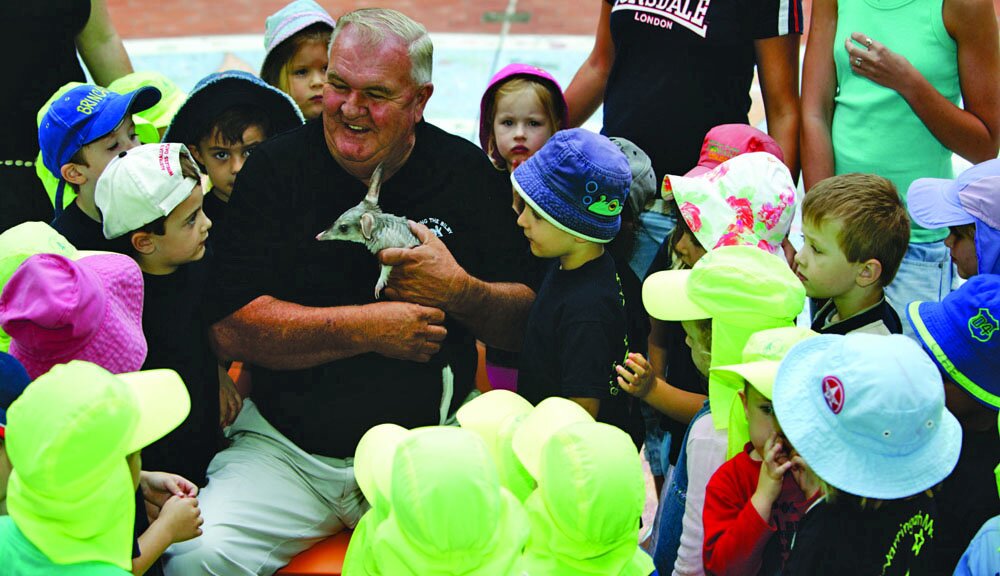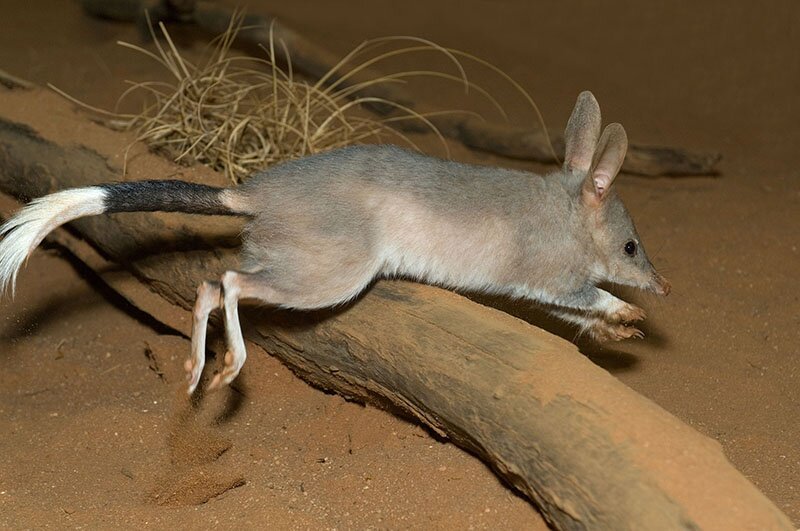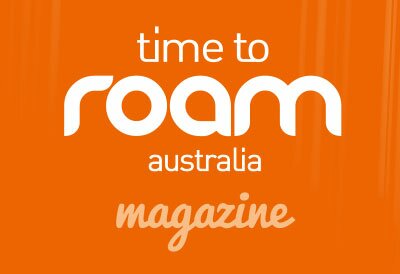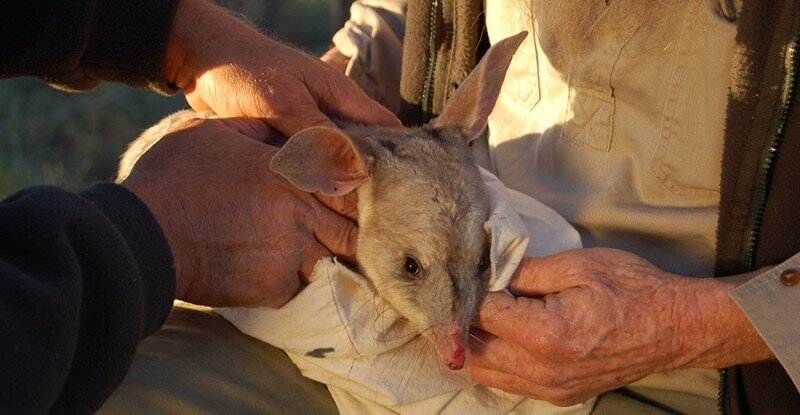Conservationist FRANK MENTHY OAM has the rare distinction of having helped bring one of Australia’s native marsupials, the bilby, back from the brink of extinction.
The co-founder of the Save the Bilby Fund writes about how he began this important work and shares some of his favourite Australian camping locations.
My first taste of outback life came back in 1964 when I boarded a train in Brisbane and travelled more than a thousand kilometres inland to remote Quilberry Station, south of Charleville.
Aged just 13, my ambition was to work on a sheep station, living the life of a cowboy like my hero John Wayne.
I organised for friend to tell my mother and was long gone by the time she found out. Her anguish was tempered by the fact I could send my wages home to help put food on the table for the rest of the family.
Initially I was disappointed to learn I would only be feeding chickens and working around the house yard. But it wasn’t long though before I did become a stockman and had the chance to see much of the unique landscape of Western Queensland. This adventure proved to be a life changing event, giving me a lifelong love of the bush and its people.

In 1958, I married Eva Branfield, a Kooma Aboriginal woman. We raised six children in Cunnamulla and each developed a love of camping in the outback. In those days if you went on holidays, you took a tarp to throw over a rope tied between 2 trees and slept in swags. This meant we could go anywhere and we all have many great memories. In the 1960s, I took my kids to a property called Currawinya to go fishing in a freshwater lake called Numulla. The lake is fed by the Paroo River and you could catch yellow belly on hand lines at any time of the day or night. Thankfully, the property is now a National Park. I may be old fashioned, but I strongly believe it made our family stronger.
How my interest in bilbies began
My wife of 38 years passed away suddenly in 1996 and I desperately needed a distraction to help overcome my grief. At the time, I worked as a ranger for Queensland Parks and Wildlife Service at Charleville. A colleague, Peter McRae, offered to take me to Astrebla Downs National Park to observe that last wild population of bilbies in Queensland. Motivated by the tragedy that this species was on the brink of extinction, I spoke with Peter about fundraising opportunities. Together, we established Save the Bilby Fund in 1999. My role has been fundraising as well as community education including school visits. I started the bilby shows in Charleville in 1999 and a Bilby Fence was completed in 2003, creating a safe enclosure protected from predators such as foxes and cats.
We released our first bilbies into the enclosure in 2006 and continue our captive breeding work at Charleville and also at Dreamworld on the Gold Coast.
The Fund is working with the Queensland Government explore more release sites for bilbies. Save the Bilby Fund has also offered grants to other organisations which other assist endangered species including the Bridled Nailtail Wallaby and the Northern Hairy-Nosed Wombat.
As a Co-Founder of Save the Bilby Fund, I urge everyone to join with our Fund and do what you can help save this very iconic Australian. It is the only Australian animal to have its own National Day, which is the second Sunday in September annually.
We are very quick to blame governments when things go wrong and a lot of the time they are to blame, but governments don’t have any money, we entrust it to them to spend on important things like health, schools and to protect areas of national significance. We must look after what we have because it belongs to all of us.

Australia is lucky to be home to some of the world’s most iconic species of mammals and yet many are in danger of extinction. Over the past 200 years 27 species of mammal have become extinct. Our work with the bilby is critical to its survival. Bilbies used to occupy more than 70 per cent of mainland Australia. Today the wild populations have been reduced to 600 in far western QLD and scattered populations in the NT and WA.
Bilbies are omnivores which eat insects, bulbs and seeds. They rarely drink in the wild, getting most of their moisture from what they eat. Most remarkably though, bilbies have the second fastest gestation of any mammal the world at just 12 – 14 days. With these attributes, bilbies should be everywhere, but predation by cats and foxes is the main cause of their demise.
You can help us in our work by:
• Buying Pink Lady chocolate bilbies at Easter. Pink Lady is a fully Australian owned company and their chocolates are made in Australia. Pink Lady makes a donation for the sale of each chocolate bilby to help us in our work.
• Making a donation or buying merchandise from our website at www.savethebilbyfund.org
• Talking with your kids and grandkids about bilbies. We have a great factsheet on our website and run a competition for kids each year to help educate them about the plight of the bilby.
Here are some of the unique Australian places which I think everyone should have the opportunity to see and experience.
1. Cradle Mountain Lake St Clair National Park, TAS
I have visited Cradle Mountain in Tasmania a few times and never fail to be in awe of its beauty. I am so grateful that this region has World Heritage listing.
2. The Kimberley, WA
It has been quite a while since I last visited the Kimberley in WA. I know there is a group of people who are trying to achieve World Heritage listing for the region – the sooner the better. When I was last there it was still virtually untouched. I would tell people that the Kimberley is one of the only places I know that we haven’t wrecked with development, but I fear that this will change unless we look after it.
3. Currawinya National Park and Charleville’s Bilby Program, QLD
Amongst many other beautiful aspects, the park has two lakes, Numalla with fresh water and 4kms away is a salt lake called Wyara. The park is very large at 154,870 hectares and is where Save the Bilby Fund built the predator-proof fence so that we could release bilbies into the park. Once visiting Currawinya, please travel the four hour trip through Cunnamulla to Charleville to see our bilby conservation work and live bilbies.
4. The drive from Port Lincoln to Streaky Bay, SA
There are many spectacular beaches along this drive, especially the ones at Coffin Bay. I also would strongly recommend the Barossa Valley- I would have liked to have spent more time there. There is so much history to be found there. I really enjoyed visiting the home of one of Australia’s icons, Sir Sidney Kidman, at Kapunda.
5. Little Beach, Two People’s Bay, WA
WA is the envy of the world with its wildflowers and beaches. One place I will always remember near Albany is Two Peoples Bay, especially a place called Little Beach. This region is home to one of Australia’s most endangered mammals – the Gilbert’s Potoroo. Visitors to this region should support the Gilbert’s Potoroo Action Group to ensure the survival of this species.






